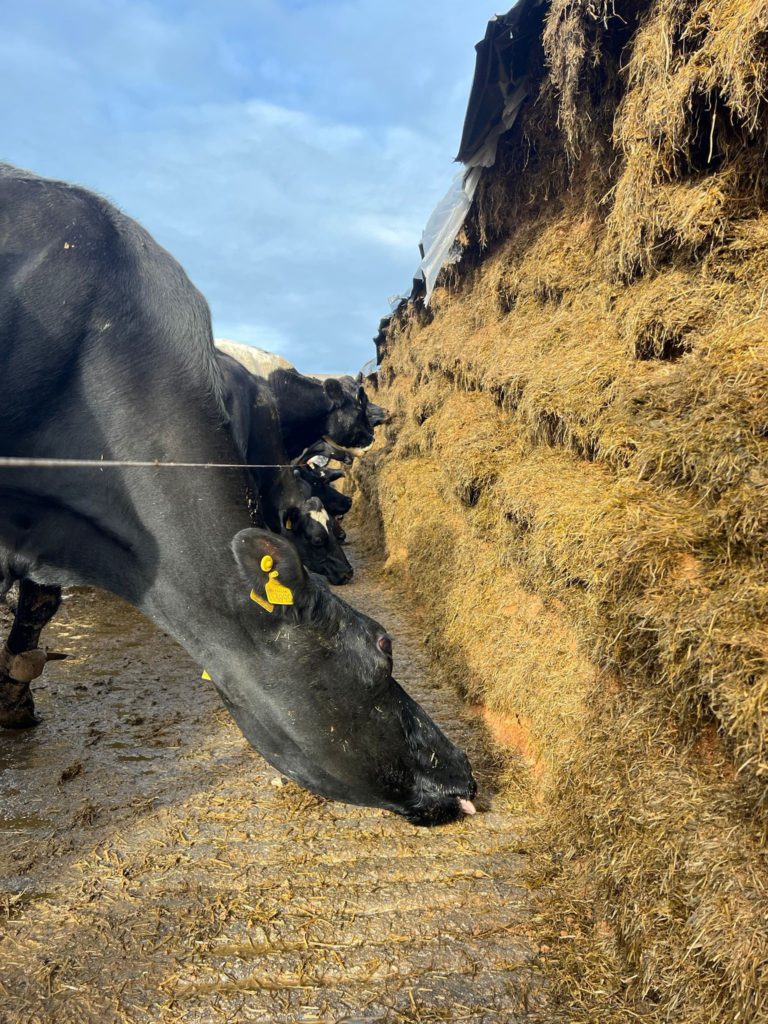
Written by Alex Bebbington, Project Officer, Rural Business School, Duchy College
Improving the quality of homegrown feed is an important consideration for farms looking to reduce their carbon footprint. Dr Dave Davies from Silage Solutions Ltd spoke about optimising silage production and quality at Farm Net Zero Monitor Farmer, Phil Kent’s, Higher Carruan dairy unit. This event was made possible with thanks to the National Lottery Community Fund who fund the Farm Net Zero project.
Dave recommended that the best forage for silage production is young, highly digestible material under a multi-cut regime. This is easier to make into high quality silage than older material, and because it has a higher feed value can help to reduce emissions associated with bought-in feed, as less is required when homegrown forage is improved.
Dave explained that the ideal dry matter for silage is 30-32%, this should be achieved by wilting rapidly and for no longer than 36 hours. When making clamp silage, grass should be layered in at 15cm depths as this is as far down as effective compaction occurs. Side sheets should be used, along with a cling film barrier and then a top sheet. There should be pressure all over the clamp, and especially at the sides where ideally gravel bags should be overlapping. The aim is to seal in carbon dioxide to create anaerobic fermentation and prevent any oxygen entering. For bales, a chopper baler is best and ideally bales should be wrapped at the stack to avoid puncturing the wrap. Bale handlers are better than spikes for the same reason.

Silage with an appropriate dry matter will increase the amount of lactic acid compared to acetic, which is good because lactic acid helps to lower silage pH and prevent dry matter and energy losses. A higher proportion of lactic acid is also important because it locks up hydrogen molecules that can otherwise form excess methane in the rumen. This excess methane is an energy loss for the animal, as well as a greenhouse gas emission.
In the UK, average losses between mowing and feeding out silage can be 25% for clamps and 10% for bales. This waste is obviously a financial cost to the farm, both from the money lost making waste silage and from the cost of buying replacement feed. But it also affects the farm’s carbon footprint per unit of feed, because there are carbon emissions associated with using diesel to make this lost silage. By focusing on methods of reducing waste, a farm can increase the amount of silage it gets for the same amount of diesel used.
Phil Kent then took the group to see the self-feed silage clamp. Phil and his team milk 300 autumn-calving Friesian-type cows on a grazing system, supplying milk for a cheese contract. Three cuts of grass/herbal ley silage, plus wholecrop peas and barley were put into a clamp measuring 80 metres by 20 metres, aiming to fill to a height of 2 metres.
By allowing the cows to feed straight from the clamp face, Phil is reducing the amount of diesel used over the winter. This has a corresponding reduction in carbon emissions compared to using machinery to carry the silage to the cows.
Key takeaways:
- Reducing waste in silage production reduces the carbon footprint per unit of feed
- Improving the quality of homegrown feed reduces the need for bought-in feed
- Self-feed silage clamps can have a lower diesel requirement, with lower emissions.
